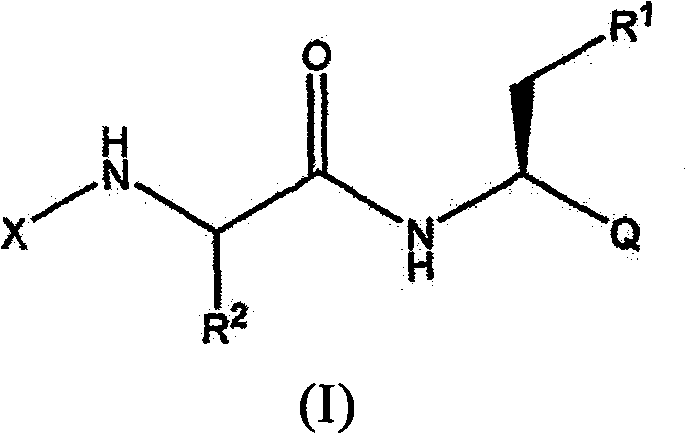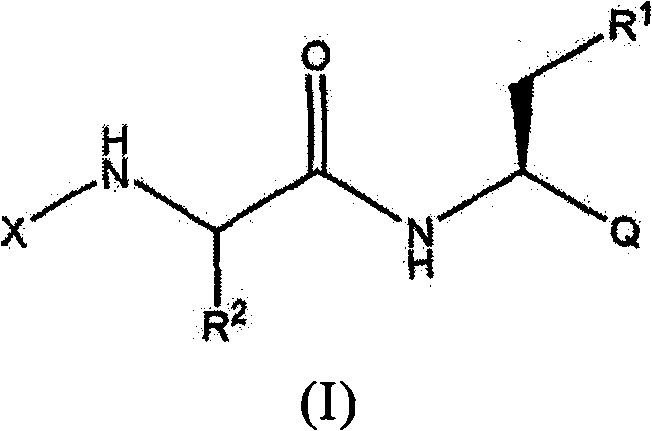Proteasome inhibitors and methods of using the same
A medicinal salt and alkyl technology, applied in the field of boric acid and boric acid ester compounds, can solve the problems of reducing the degradation rate of p53 protein in animals
- Summary
- Abstract
- Description
- Claims
- Application Information
AI Technical Summary
Problems solved by technology
Method used
Image
Examples
Embodiment A1
[0507] (1R)-1-[(3aS,4S,6S,7aR)-hexahydro-3a,5,5-trimethyl-4,6-methylene-1,3,2-benzodioxanborol- Synthesis of 2-yl]-3-methylbutylamine hydrochloride
[0508] Step 1: 2-(2-Methylpropyl)-(3aS,4S,6S,7aR)-hexahydro-3a,5,5-trimethyl-4,6-methylene-1,3,2 - Benzodioxin borole
[0509]
[0510] A mixture of (+)-pinanediol (23.9 g, 0.140 mol) and 2-methylpropylboronic acid (15 g, 0.147 mol) in diethyl ether (300 mL) was stirred at room temperature for 24 hours. The mixture was dried over anhydrous sodium sulfate and purified by column chromatography (silica gel 230-400 mesh), eluting with a mixture of hexane:ethyl acetate 90:10. The product was obtained as a clear oil (32.6 g, 94% yield).
[0511] 1 H NMR (DMSO-d 6 ): 4.28 (1H, dd, J = 8.8Hz, 2.0); 2.30 (1H, m); 2.18 (1H, m); 1.96 (1H, t, J = 5.3); 1.86 (1H, m); 1.78 ( 1H, set, J = 6.8); 1.68 (1H, m); 1.30 (3H, s); 1.25 (3H, s); 1.01 (1H, d); 0.9 (6H, d, J = 6.6); 3H, s); 0.69 (2H, m).
[0512] Step 2: 2-[(1S)-1-Chloro-3-methy...
Embodiment A2
[0525] 2-(2-Methylpropyl)-(3aS,4S,6S,7aR)-hexahydro-3a,5,5-trimethyl4,6-methylene-1,3,2-benzodioxaborole alternate synthesis of
[0526] Step 1: 2-(1-methylethoxy)-(3aS,4S,6S,7aR)-hexahydro-3a,5,5-trimethyl-4,6-methylene-1,3, 2-Benzodioxin borole.
[0527]
[0528] To a solution of (1S, 2S, 3R, 5S)-(+)-pinanediol (50.0g, 0.293mol) in anhydrous tetrahydrofuran (350ml) was slowly added triisopropoxyborane while at 0°C Stir under nitrogen. After 2 hours, the solvent was removed by rotary evaporation. The oily residue was redissolved in hexane (150ml), and the solution was filtered to remove a small amount of white solid. The filtrate was concentrated by rotary evaporation to obtain a clear oily product (62.6 g, yield 90%).
[0529] 1 H NMR (DMSO-d6): 4.31-4.20 (2H, m); 2.34-2.16 (2H, m); 1.96 (1H, t, J=5.5); 1.90-1.85 (1H, m); 1H, m); 1.32(3H, s); 1.31(1H, d, J=7.6); 1.25(3H, s); 1.14(3H, d, J=6.1); 1.13(3H, d, J=6.1 ); 0.81 (3H, s).
[0530] Step 2: 2-(2-Methylpropyl...
Embodiment B1
[0534] N-[(1S)-1-[[[(1R)-1-[(3aS, 4S, 6S, 7aR)-hexahydro-3a,5,5-trimethyl-4,6-methylene- 1,3,2-Benzodioxanborol-2-yl]-3-methylbutyl]amino]carbonyl]-4-[[imino(nitroamino)methyl]amino]butyl-carbamic acid 1,1-Dimethylethyl ester
[0535]
[0536] Method A: HOAt / HATU
[0537] To BocNH(NO 2 ) ArgOH (15.7g, 49.3mmol) in anhydrous DMF (100ml) solution, add HATU (O-(7-azabenzotriazol-1-yl)-1,1,3,3-tetramethyluronium Hexafluorophosphate; 18.7 g, 49.3 mmol) and HOAt (1-hydroxy-7-azabenzotriazole; 6.71 g, 49.3 mmol). The mixture was cooled to 0°C and N-methylmorpholine (13.6ml, 0.123mol) was added. After 10 minutes, (1R)-1-[(3aS,4S,6S,7aR)-hexahydro-3a,5,5trimethyl-4,6-methylene-1 from Example A.1 was added, 3,2-Benzodioxaborol-2-yl]-3-methylbutylamine hydrochloride (12.4 g, 41.1 mmol). The cooling bath was removed and the mixture was stirred at room temperature for 4.5 hours. The mixture was diluted with ethyl acetate (800ml), washed with 2% citric acid solution (2×150ml), 2% ...
PUM
 Login to View More
Login to View More Abstract
Description
Claims
Application Information
 Login to View More
Login to View More - R&D
- Intellectual Property
- Life Sciences
- Materials
- Tech Scout
- Unparalleled Data Quality
- Higher Quality Content
- 60% Fewer Hallucinations
Browse by: Latest US Patents, China's latest patents, Technical Efficacy Thesaurus, Application Domain, Technology Topic, Popular Technical Reports.
© 2025 PatSnap. All rights reserved.Legal|Privacy policy|Modern Slavery Act Transparency Statement|Sitemap|About US| Contact US: help@patsnap.com



